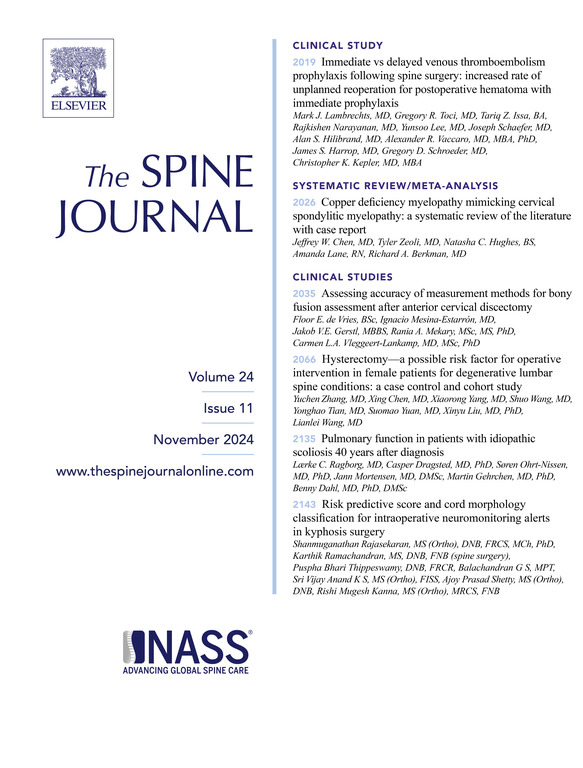Does intraoperative antiseptic solution soaking reduce microbial contamination in spine surgery? A randomized controlled trial
IF 4.7
1区 医学
Q1 CLINICAL NEUROLOGY
引用次数: 0
Abstract
BACKGROUND CONTEXT
Surgical site infections (SSIs) are a significant complication in spine surgery, particularly in instrumented procedures, leading to increased morbidity and healthcare costs. Despite standard preoperative disinfection protocols, bacterial contamination remains prevalent. Strategies such as intraoperative antiseptic irrigation have been explored to mitigate contamination, yet the comparative efficacy of different antiseptic solutions remains unclear.
PURPOSE
This study aimed to evaluate the effectiveness of intraoperative antiseptic solution soaking with normal saline (NS), povidone-iodine (PVP-I), and chlorhexidine gluconate (CHG) in reducing bacterial contamination in lumbar instrumented fusion surgery.
STUDY DESIGN/SETTING
A single-center, single-blinded, randomized controlled trial was conducted at a tertiary medical center in Taiwan.
PATIENT SAMPLE
A total of 105 patients undergoing posterior lumbar interbody fusion surgery were enrolled and randomly assigned to three groups: NS (n=35), PVP-I (n=35), or CHG (n=35). Patients with prior lumbar procedures, known allergies to antiseptics, previous spinal infections, trauma, or tumors were excluded.
OUTCOME MEASURES
The primary outcome was the reduction in bacterial contamination, assessed via intraoperative cultures from three sites—superficial tissues, deep tissues, and implant surfaces—before and after antiseptic irrigation. Secondary outcomes included the incidence of postoperative SSIs and clinical complications over a 6-month follow-up period.
METHODS
Patients were randomized into three groups, each receiving a 3-minute soak with the assigned antiseptic solution before wound closure, followed by normal saline irrigation. Swab samples were collected pre- and postirrigation for bacterial culture and 16S rRNA PCR analysis. Statistical analysis was performed using logistic regression and Bonferroni correction for multiple comparisons.
Results
Among 105 patients, preirrigation bacterial culture positivity rates were 49.5% in superficial tissues, 31.4% in deep tissues, and 32.4% on implants. Postirrigation, NS showed no significant bacterial reduction, while PVP-I reduced superficial contamination (55.0%, p=.015) but no significant effect in deeper tissues and implants. CHG showed the greatest bacterial reduction, significantly outperforming NS (OR: 0.06, 95% CI: 0.01–0.54, p=.011) and PVP-I (OR: 0.06, 95% CI: 0.01–0.56, p=.012) on implant surfaces. Despite these differences in culture rate, SSI rates remained low and comparable among groups (p=.72), with no reported antiseptic-related complications.
CONCLUSION
This study confirms that bacterial contamination remains high despite standard preoperative disinfection in lumbar fusion surgery. Among the tested antiseptic solutions, CHG demonstrated superior efficacy in reducing bacterial residues, particularly on implant surfaces. These findings support CHG as a promising antiseptic for intraoperative irrigation in spine surgery. Further multicenter studies are needed to validate its impact on reducing SSIs and improving long-term outcomes.
Level of evidence
Level II.
术中浸泡消毒液能减少脊柱手术中的微生物污染吗?随机对照试验。
背景背景:手术部位感染(ssi)是脊柱外科手术的一个重要并发症,特别是在器械手术中,它会导致发病率和医疗费用的增加。尽管有标准的术前消毒方案,但细菌污染仍然普遍存在。术中消毒冲洗等策略已被探索以减轻污染,但不同消毒溶液的比较效果仍不清楚。目的:本研究旨在评价术中使用生理盐水(NS)、聚维酮碘(PVP-I)和葡萄糖酸氯己定(CHG)浸泡消毒液减少腰椎植骨融合手术中细菌污染的效果。研究设计/环境:在台湾某三级医疗中心进行单中心、单盲、随机对照试验。患者样本:共纳入105例接受后路腰椎椎体间融合手术的患者,并随机分为三组:NS (n=35), PVP-I (n=35)或CHG (n=35)。既往腰椎手术、已知对防腐剂过敏、既往脊柱感染、创伤或肿瘤的患者被排除在外。结果指标:主要结果是细菌污染的减少,通过术中三个部位(浅表组织、深部组织和种植体表面)在消毒冲洗前后的培养来评估。次要结果包括术后ssi的发生率和六个月随访期间的临床并发症。方法:将患者随机分为三组,每组在伤口闭合前用指定的消毒溶液浸泡3分钟,然后用生理盐水冲洗。冲洗前后收集拭子样本进行细菌培养和16S rRNA PCR分析。采用logistic回归和Bonferroni校正进行统计学分析。结果:105例患者中,冲洗前浅表组织细菌培养阳性率为49.5%,深层组织为31.4%,种植体为32.4%。冲洗后,NS没有明显的细菌减少,而PVP-I减少了表面污染(55.0%,p=0.015),但对深层组织和种植体没有显著影响。CHG表现出最大的细菌减少,显著优于NS (OR: 0.06, 95% CI: 0.01-0.54, p = 0.011)和PVP-I (OR: 0.06, 95% CI: 0.01-0.56, p = 0.012)。尽管培养率存在这些差异,但SSI率仍然很低,各组之间具有可比性(p=0.72),没有报道与防腐剂相关的并发症。结论:本研究证实,尽管在腰椎融合手术中进行了标准的术前消毒,但细菌污染仍然很高。在所测试的抗菌溶液中,CHG在减少细菌残留方面表现出卓越的功效,特别是在种植体表面。这些发现支持CHG作为脊柱外科术中冲洗的一种有前途的防腐剂。需要进一步的多中心研究来验证其对减少ssi和改善长期预后的影响。证据等级:二级。
本文章由计算机程序翻译,如有差异,请以英文原文为准。
求助全文
约1分钟内获得全文
求助全文
来源期刊

Spine Journal
医学-临床神经学
CiteScore
8.20
自引率
6.70%
发文量
680
审稿时长
13.1 weeks
期刊介绍:
The Spine Journal, the official journal of the North American Spine Society, is an international and multidisciplinary journal that publishes original, peer-reviewed articles on research and treatment related to the spine and spine care, including basic science and clinical investigations. It is a condition of publication that manuscripts submitted to The Spine Journal have not been published, and will not be simultaneously submitted or published elsewhere. The Spine Journal also publishes major reviews of specific topics by acknowledged authorities, technical notes, teaching editorials, and other special features, Letters to the Editor-in-Chief are encouraged.
 求助内容:
求助内容: 应助结果提醒方式:
应助结果提醒方式:


